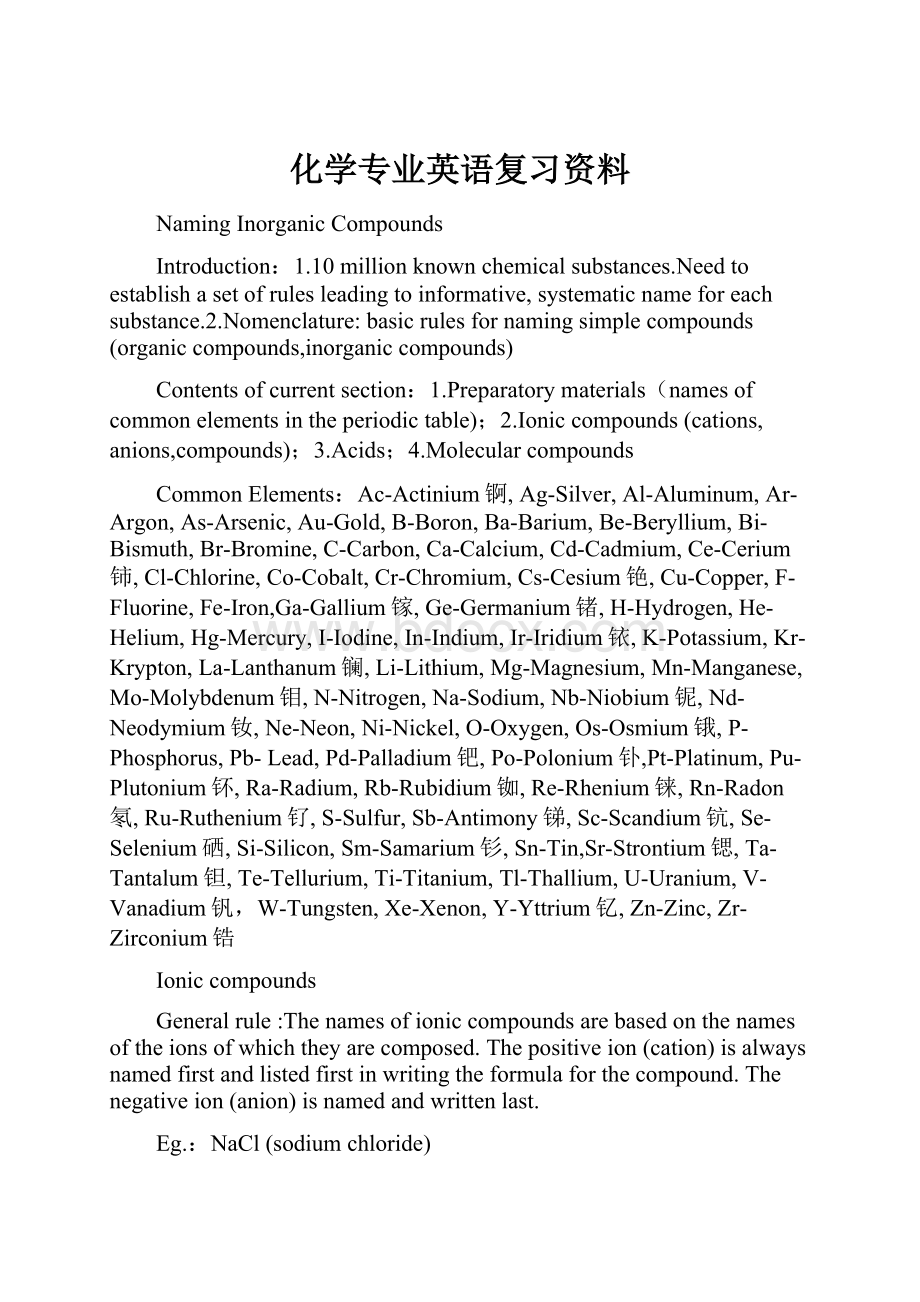化学专业英语复习资料.docx
《化学专业英语复习资料.docx》由会员分享,可在线阅读,更多相关《化学专业英语复习资料.docx(17页珍藏版)》请在冰豆网上搜索。

化学专业英语复习资料
NamingInorganicCompounds
Introduction:
1.10millionknownchemicalsubstances.Needtoestablishasetofrulesleadingtoinformative,systematicnameforeachsubstance.2.Nomenclature:
basicrulesfornamingsimplecompounds(organiccompounds,inorganiccompounds)
Contentsofcurrentsection:
1.Preparatorymaterials(namesofcommonelementsintheperiodictable);2.Ioniccompounds(cations,anions,compounds);3.Acids;4.Molecularcompounds
CommonElements:
Ac-Actinium锕,Ag-Silver,Al-Aluminum,Ar-Argon,As-Arsenic,Au-Gold,B-Boron,Ba-Barium,Be-Beryllium,Bi-Bismuth,Br-Bromine,C-Carbon,Ca-Calcium,Cd-Cadmium,Ce-Cerium铈,Cl-Chlorine,Co-Cobalt,Cr-Chromium,Cs-Cesium铯,Cu-Copper,F-Fluorine,Fe-Iron,Ga-Gallium镓,Ge-Germanium锗,H-Hydrogen,He-Helium,Hg-Mercury,I-Iodine,In-Indium,Ir-Iridium铱,K-Potassium,Kr-Krypton,La-Lanthanum镧,Li-Lithium,Mg-Magnesium,Mn-Manganese,Mo-Molybdenum钼,N-Nitrogen,Na-Sodium,Nb-Niobium铌,Nd-Neodymium钕,Ne-Neon,Ni-Nickel,O-Oxygen,Os-Osmium锇,P-Phosphorus,Pb-Lead,Pd-Palladium钯,Po-Polonium钋,Pt-Platinum,Pu-Plutonium钚,Ra-Radium,Rb-Rubidium铷,Re-Rhenium铼,Rn-Radon氡,Ru-Ruthenium钌,S-Sulfur,Sb-Antimony锑,Sc-Scandium钪,Se-Selenium硒,Si-Silicon,Sm-Samarium钐,Sn-Tin,Sr-Strontium锶,Ta-Tantalum钽,Te-Tellurium,Ti-Titanium,Tl-Thallium,U-Uranium,V-Vanadium钒,W-Tungsten,Xe-Xenon,Y-Yttrium钇,Zn-Zinc,Zr-Zirconium锆
Ioniccompounds
Generalrule:
Thenamesofioniccompoundsarebasedonthenamesoftheionsofwhichtheyarecomposed.Thepositiveion(cation)isalwaysnamedfirstandlistedfirstinwritingtheformulaforthecompound.Thenegativeion(anion)isnamedandwrittenlast.
Eg.:
NaCl(sodiumchloride)
Namingcations
Monatomicions(takethenameoftheelementitself)
Zn2+(zincion),Al3+(aluminumion)
Note:
foranelement(especiallytransitionmetals)withmorethan1positiveion,thepositivechargeoftheionisindicatedbyaRomannumeralinparenthesesfollowingthenameofthemetal:
Fe2+---iron(II)ion,Cu+---copper(I)ion
Ifunsure,usetheRomannumeraldesignationofchargesaspartofthename.
Namingcations
Note:
Awidelyusedoldermethodtodistinguishbetweentwodifferentlychargedionsofametalistoapplytheending–ousforthelowerchargedionsor-icforthehigherchargedions,respectively.TheyareaddedtotherootoftheLatinnameoftheelement.
Eg.:
Fe2+(ferrousion),Cu+(cuprousion)
Fe3+(ferricions),Cu2+(cupricion)
Namingcations
Polyatomiccations:
Groupsofatomswithapositivecharge.
NH4+---ammoniumionHg22+---mercury(I)ionormercurousion
Note:
Hg2+---mercury(II)ion,ormercuricion
Commonions:
Cations:
ammonium,cesium,copper(I)orcuprous,hydrogen,lithium,potassium,silver,sodium.(+1ions);barium,cadmium,calcium,cobalt(II)orcobaltous,copper(II)orcupric,iron(II)orferrous,lead(II)orplumbous,magnesium,manganese(II)ormanganous,mercury(I)ormercurous,mercury(II)ormercuric,nickel,strontium,tin(II)orstannous,zinc.(2+ions);aluminum,chromium(III)orchromic,iron(III)orferric.(3+ions)
Naminganions
Monatomicanions(namedbydroppingtheendingofthenameoftheelementandaddingtheending-ide):
Naminganions
Polyatomicanions
Note:
onlyafewpolyatomicanionsendin-ide:
OH-hydroxideion,CN-cyanideionO22-peroxideion,N3-azideion
Naminganions
Oxyanions(polyatomicandoxygen-containing):
whenanelementformstwooxyanions,thenameoftheonecontainingmoreoxygenendsin-ate;thenameoftheonewithlessoxygenendsin-ite:
Eg.:
NO2-nitriteion,SO32-sulfiteion,NO3-nitrateion,SO42-sulfateion
Naminganions
Note:
whentheseriesofanionsofagivenelementextendstothreeorfourmembers,prefixesarealsoemployed.Theprefixhypo-indicateslessoxygen,andper-moreoxygen:
Eg:
ClO-hypochloriteion,ClO2-chloriteionClO3-chlorateion,ClO4-perchlorateionchlor---rootofchlorine
Naminganions
Practice:
selenateion(?
);seleniteion(?
)perbromate(?
),hypobromite(?
)
Note:
exceptionstorules:
permanganateionisMnO4-,manganateionisMnO42-.ferrate-(orperferrate)FeO4-,chromateCrO42-,dichromateCr2O72-
Naminganions
Polyatomicanionswithhydrogenions
Theseionsarenamedbyprefixingthewordhydrogenordihydrogen,asappropriate,tothenameofthehydrogen-freeanion.Alternativewayistousetheprefixbi-:
Eg.:
HCO3-hydrogencarbonate(orbicarbonate)ion;HSO4-hydrogensulfate(orbisulfate)ion;H2PO4-dihydrogenphosphateion
Commonions
Anions:
acetate,azide,bromide,chlorate,chloride,cyanide,dihydrogenphosphate,fluoride,hydride,hydrogencarbonateorbicarbonate,hydrogensulfateorbisulfate,hydroxide,iodide,nitrate,nitrite,perchlorate,permanganate,thiocyanate,cyanate.(1-ions);carbonate,chromate,dichromate,ferrate,hydrogenphosphate,oxide,peroxide,sulfate,sulfide,sulfite,thiosulfate.(2-ions);nitride,phosphate,phosphide.(3-ions).
Namingioniccompounds
Writetheformulasforioniccompoundsbycombiningthenamesofcationsandanions:
bariumbromide-BaBr2
copper(II)nitrateorcupricnitrate-Cu(NO3)2
aluminumoxide-Al2O3
mercury(I)chlorideormercurouschloride
Hg2Cl2
ferricoxide,Fe2O3
Practice:
Namethefollowingcompounds:
(a)K2SO4;(b)Ba(OH)2;(c)FeCl3(d)NH4Cl;(e)Cr2O3;(f)Co(NO3)2
Writethechemicalformulasforthefollowingcompounds:
(a)calciumcarbonate;(b)sodiumfluoride;(c)iron(II)perchlorate;(d)magnesiumsulfate;(e)silversulfide;(f)leadnitrate.
NamingAcids
Anacidhereisdefinedasasubstancewhosemoleculesyieldhydrogenions(H+)whendissolvedinwater.
Rule:
Thenameofannon-oxyacidisrelatedtothenameoftheanion.Anionswiththeending-ideassociatewithacidshavinghydro-prefixandan-icending:
Eg:
Chloride(Cl-)tohydrochloricacid(HCl)sulfide(S2-)tohydrosulfuricacid(H2S)
Note:
onlywatersolutionofHCliscalledhydrochloricacid,thepurecompoundiscalledhydrogenchloride.
Namingtheacids
Foracidsderivedfromoxyanions(oxyacids)
Rule:
Iftheanionhasan–ate(-ite)ending,thecorrespondingacidisgivenan–ic(-ous)ending.Prefixesareretained:
Namingtheacids
Exercises
Namethefollowingacids:
(a)HCN,HSCN;(b)HNO3,HNO2(c)H2SO4(d)H2SO3
Givethechemicalformulasfor
(a)hydrobromicacid;(b)phosphoricacid.
Namingmolecularcompounds
Rule:
Theproceduresfornamingbinary(two-element)molecularcompoundsaresimilartothosefornamingioniccompounds.Theelementwiththepositivenatureisnamedfirstandalsoappearsfirstinthechemicalformula.Thesecondelementisnamedwithan–ideending.
Eg.:
HClhydrogenchloride
Namingmolecularcompounds
Prefixesareusedindifferentiatingseveralbinarycompoundsformedbetweennonmetals.
Eg:
CO-carbonmonoxideCO2-carbondioxide
MeaningoftheGreekprefixes:
mono-
(1);di-
(2);tri-(3);tetra-(4);penta-(5);hexa-(6);hepta-(7);octa-(8);nona-(9);deca-(10)
Namingmolecularcompounds
Note:
whentheprefixendsinaoroandthenameoftheanionbeginswithavowel(suchasoxide),theaoroisoftendropped.Theprefixmono-isusuallyomittedforthefirst-namedelement.
Eg.:
Cl2O-dichlorinemonoxide;NF3-nitrogentrifluoride;N2O4-dinitrogentetroxide;P4S10-tetraphosphorusdecasulfide;
Exercises
Namethefollowingcompounds:
(a)SO2;(b)PCl5;(c)N2O3
Givethechemicalformulafor(a)silicontetrabromide(b)disulfurdichloride
ExercisesforReview
Sodiumfluoride,magnesiumbromide,hydrogeniodide,sodiumazide,calciumphosphide,copper(I)chloride,potassiumazide,manganese(IV)oxide
K2SO3,Ca(MnO4)2,Ba3(PO4)2,H3PO4,H2SO4,HNO3,ZnO,BaO2,FeO,CuSO4•5H2O,Mn3(PO4)2
Metaphosphoricacid,phosphoricacid,hypophosphorousacid,phosphorousacid,(hypo)phosphite,(meta)phosphate
ammoniumacetate,perbromicacid,potassiumnitrite,sodiumperoxide,ammoniumdichromate,sodiumcarbonate,silvernitrate,aluminumacetate,hydrosulfuricacid,sulfurousacid,perferricacid,perferrateion,hypoioditeion,iodicacid,chlorousacid,hydrochloricacid
B2O3,SiO2,PCl3,SiCl4,BrF3,IBr,N2S5,PCl3,SiS,S4N2
Exercise:
learningforuse
Whenammoniumthiocyanateandbariumhydroxideoctahydratearemixedatroomtemperature,anendothermicreactionoccurs.(writethechemicalequation).Asaresultofthisreaction,thetemperatureofthesystemdropsfromabout20°Cto-9°C.
Thereactionofpowderedaluminumwithferricoxide(knownasthethermitereaction)ishighlyexothermic.Oncestarted,thereactionproceedsvigorouslytoformaluminumoxideandmolteniron.(writethechemicalequation)
NomenclatureforOrganicCompoundsandGroups
WhyDoWeNeedaSeparateSetofRules?
Examinesometypicalorganiccompounds(Nametheseusingtypicalcovalentrules)
CH4:
CarbontetrahydrideC2H6:
Dicarbonhexahydride
Thatwasn’tsobad,right?
Howaboutthese:
C4H10:
TetracarbondecahydrideC5H12:
Pentacarbonhydride
Seemypoint?
Memorizingtoomanyprefixesforlargenumbers
Isomers:
Ifthat’snotenough,howaboutthisone:
Rules
•Identifythelongestunbranchedchainofcarbons
•Nameitasnormal
•Identifythebranch
•Nameitbutgiveita“–yl”suffix
•Putthenamesofallbranchesfirst,thenputnameoflongestchain
•Putthenumberofthecarbonthebranchison(startnumberingfromtheclosestsingleend)
Nomenclatureforsaturatedhydrocarbons
a.Alkanes(CnH2n+2烷烃)---+ane
forn<=4:
methane(甲烷),ethane(乙烷),propane(丙烷),butane(丁烷).
Alkane
forn>4,fornormalalkanes
AGreekprefix+anesuffix(if“-aa-”,dropone“a”)
5pent(a)-,6hex(a)-,7hept(a)-,8oct(a)-,9non(a)-,10dec(a)-,11undec(a)-,12dodec(a)-,13tridec(a)-,14tetradec(a)-,15pentadec(a)-16hexadec(a)-,17heptadec(a),18octadec(a)-,19nonadec(a)-,20eicos(a)-,22docos(a)-,24tetracos(a)-,30triac